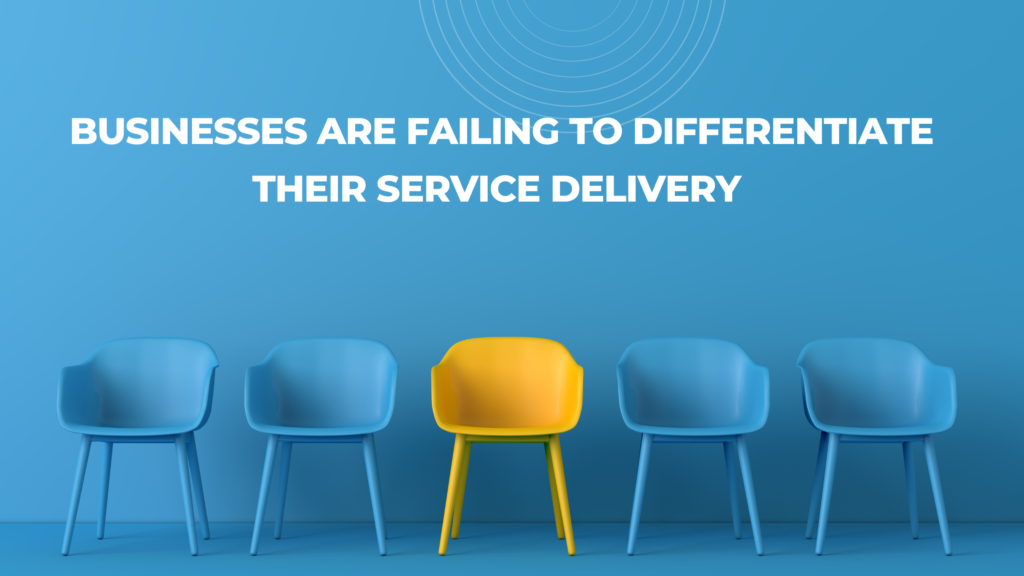I like to ask to ask leadership teams this question, “Were your competitors at the last conference or business gathering that you attended?” Of course the answer is often, “Yes.” The next question would be, “So which business is going to be most efficient at implementing what was shared?” This second question is designed to bring the team to a powerful pause moment, when everyone goes, “We’d better get cracking.”
Many businesses are selling the same products, in the same business markets and are drowning in a sea of sameness, without having differentiated themselves. I believe that many remain rooted in this sameness capsule because they are either oblivious to the severity of the problem, immune to the pain of customer complaints, or immobilized by the sheer weight of not knowing where to start to correct the problem.
Line of sight is an important horizon-mapping input. When leaders make it a point to look at the competitive service delivery ecosystem and decide how they will differentiate themselves, it can become a transformational moment to the business.
Every business can find a way to stand out from the pack.
There are many approaches that businesses can take to differentiate themselves. One approach is to promote the uniqueness of the business, its products and its services, another is to innovate and revolutionize the industry. Think Fed Ex introducing its tracking device and think Tesla revolutionizing the car industry. Of course, on a smaller scale, every business can find a way to stand out from the pack.
One of the first acts for commanding the competitive space has to do with really understanding what customers expect and then translating that into a lever for driving great outcomes along the journeys that customers experience, during their many transactions with the business. It’s not happenstance that the businesses that understand their customers’ expectations, are at the top of their respective food chains.
When customers have to go too far and too deep into the business for information, competitive ground is lost. Why is it that the first point of interaction does not offer the customer the solution options that he or she desires? If a customer is in a face to face interaction with customer contact staff, the latter should have all of the information needed within ready reach, as well as the authority to make a decision on-spot. Sourcing information should be even easier if the customer is conducting a transaction online.
Whenever I speak with leadership teams, I suggest that an important competitive differentiator is the ability of first responders to make on-spot decisions that are responsive and responsible.
Whenever I speak with leadership teams, I suggest that an important competitive differentiator is the ability of first responders to make on-spot decisions that are responsive and responsible. Responsive to the customer’s needs in the delivery of swift, smart solutions and responsible in managing the risk to the business. This should be their superpower.
The question of having on-demand, democratized information, is one with which businesses will be faced in the near future. Unlike the pandemic that descended upon us without much warning, providing information and decision-making as close to the customer as possible, can be implemented within a timeframe that, for now, is under the control of the business.
Customers love to conduct business where their journeys are simple and uncomplicated. We’ve all gotten used to interacting less with humans and more with digital assistants. Every business should be combing its existing transaction journeys to see which processes and steps can automated or enhanced through the use of add-on technology. The thing is that there are so many apps that support automation of processes, that upgrades, in many cases, can be quick and painless, whilst delivering ground-breaking benefits for customers.
Customization and individualization are fast becoming part of the customer’s new suite of expectations.
We need to bear in mind that going forward to the next normal, the offerings that are considered unique today, will need to be packaged as standard features tomorrow.
Finally, customization and individualization are fast becoming part of the customer’s new suite of expectations. Have you ever asked a customer contact representative if an order can be changed to suit your preference and been told, “No?”
Well the bad news is that the businesses that perpetuate this outdated practice are liable to fade into irrelevance. The good news is that the businesses that offer customization as a part of their normal offering, are giving themselves a chance at becoming heroes to their customers.
The best news is that businesses still have the time to decide their fate.

